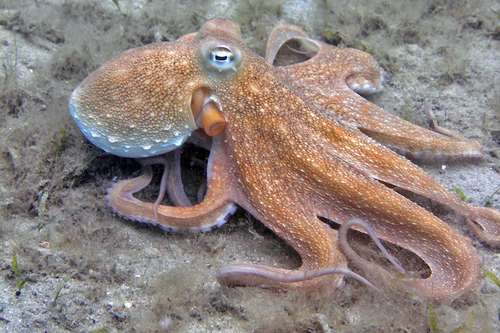
Description:
Scientific Name: Octopus vulgaris
Lifespan: 1-2 years
The common octopus (Octopus vulgaris) is a member of the Cephalopoda class of mollusks. One of the most intellectual and most extensively researched octopus species is Octopus vulgaris. The common octopus goes out to hunt around dusk. The octopus prefers bivalve mollusks (like cockles), crayfish, and crabs but will consume nearly everything it can grab. It has the ability to alter its hue to better blend in with its environment and can leap upon any unwary prey that crosses its way. It can penetrate shelled mollusks’ shells by using its beak. Additionally, it has venom to control its prey.
Their brains and neurological systems have grown in size as they have evolved. A person has roughly 500 million neurons in their body, which is almost as many as dogs. They possess the intelligence to recognise brightness, find their way through mazes, identify specific individuals, figure out how to open jars, and even rob lobster traps.
Habitat
This species is found all over the world. It is widespread in Japanese seas, the Eastern Atlantic Ocean, and the Mediterranean Sea.
Tropical, subtropical, and temperate seas between the surface and a depth of 100 to 150 metres are where you can find octopus vulgaris. Polar or subpolar regions don’t have it. It is a resident of coastal waters and the upper continental shelf.

Behavior
The octopus vulgaris lives alone and defends its territory. Animals live close to other octopuses of the same size. If there are multiple animals in a tank, they will try to establish a home or settle down apart from one another.
Only during mating and spawning does this individualistic behavior change, but even then, females continue to care for their eggs alone. O. vulgaris appears to be a really stationary species when not migrating in- or offshore. The creatures stay in their dens, leaving them at dusk for hunting expeditions and returning at dawn, according to underwater studies. Food-related excursions during the day are shorter in duration. While others switch holes multiple times over a few days, certain octopuses may live in the same place for a longer period of time.
Keeping as a Pet/ In Captivity
The common octopus comes highly recommended if you are thinking about getting an octopus as a pet for the first time and are trying to decide which species you would want to adopt. For a young person, a tank with a 50-gallon capacity will be adequate; however, if you have the room and finances, a 100-gallon tank would be preferable. The common octopus can survive in a wide variety of water temperatures, although they thrive best when the temperature is between 15 and 16 °C.
The common octopus has the benefit of not being a fussy eater. Even frozen fish will suffice as food. Most feeding occurs between twilight and dawn, and the best time to watch your animal companion is at night.
Table





